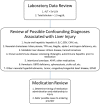An electronic medical records-based approach to identify idiosyncratic drug-induced liver injury in children
- PMID: 31792283
- PMCID: PMC6888850
- DOI: 10.1038/s41598-019-54075-4
An electronic medical records-based approach to identify idiosyncratic drug-induced liver injury in children
Abstract
Drug-induced liver injury (DILI) is the leading cause of liver failure in the United States and the most common cause of drug recall. As opposed to the recognized direct toxicity of super-therapeutic acetaminophen or chemotherapeutic agents in children, limited data exists for pediatric populations on the incidence of idiosyncratic DILI (iDILI) that may develop independently of drug dose or duration of administration. To improve the detection of adverse drug reactions at our hospital, we utilized electronic medical records-based automated trigger tools to alert providers of potential iDILI. Clinical criteria concerning for iDILI were defined as serum ALT > 5x or serum bilirubin > 1.5x upper limit of normal in the setting of medication exposure. Over a two year period, 12 patients were identified as having possible or probable iDILI. Out of the identified patients, three were males, and the mean age was 10.8 years. Implicated agents included eight antibiotics, two anti-epileptics, one anti-psychotic, and one anti-inflammatory medication. Roussel-Uclaf Causality Assessment Methods identified one "possible" case, 11 "probable" cases, and one "highly probable" case of iDILI. Improved awareness and more vigilant programming can generate better data on iDILI and improve our understanding of the condition and its incidence in children.
Conflict of interest statement
The authors declare no competing interests.
Figures
References
-
- Mindikoglu AL, Magder LS, Regev A. Outcome of liver transplantation for drug-induced acute liver failure in the United States: analysis of the United Network for Organ Sharing database. Liver transplantation: official publication of the American Association for the Study of Liver Diseases and the International Liver Transplantation Society. 2009;15:719–729. doi: 10.1002/lt.21692. - DOI - PubMed
MeSH terms
Substances
LinkOut - more resources
Full Text Sources
Medical
Research Materials


